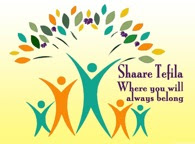Devar Torah - Shabbat February 20, 2016
This week's portion Tetzaveh teaches us an important lesson related to Jewish Disability Awareness and Inclusion Month (JDAIM). As we read about the vestments to be designed and sewn for the "kohanim" (priests) and the "kohen gadol" (high priest) we learn how the beautiful breast plate is to be made. 12 different gem stones are to be arranged on the metal representing the 12 tribes of Israel. The obvious point is that the high priest, instead of being tempted to think how great, special and powerful he is, is supposed to think how he represents the entire community of Israel. The spiritual power he has to conduct the sacred worship service in the "mishkan" (the desert sanctuary) isn't due to any special skill or talent he possesses, but rather it comes from the entire community itself.
But there is another lesson we can learn. The high priest could also think that his own tribe - the tribe of Levi - is the most important. The "kohanim" are a sub-set of the tribe of Levi and the "kohanim" are designated for their sacred work. They live isolated from the rest of the community and mostly interact with other "kohanim". They only meet other Israelites when they perform the sacrificial service. Otherwise they never ventured out into the community and, when the Temple was standing in Jerusalem, they never traveled outside of the Temple precincts. By wearing the bejeweled breast plate the high priest is reminded that there are other tribes with spiritual needs and desires that have to be satisfactorily represented by him in his holy work.
This lesson was highlighted to me when I attended 2 meetings this month in Washington, DC. I proudly represent the Rabbinical Assembly (RA - the organization of Conservative rabbis) on issues affecting people with disabilities. In that role I raise awareness to RA members and represent the RA at national conferences of organizations that advocate for disability rights and inclusion. At the Jewish Disability Advocacy Day on Feb 10 and at the White House sponsored panel discussion on the current state of inclusion in the Jewish community on Feb 18 it was clear to me how passionate these advocates are. Their passion though - for at least 95% of those in attendance - comes from a personal connection with disabilities. I am involved in this cause because my only sibling, my brother, is a person with intellectual and developmental disabilities. The people who spoke to us and all those in attendance were either themselves people with disabilities or had close relatives with disabilities. Obviously we are passionate about this cause because we know what needs to be done for ourselves and for our relatives.
This is true of all advocacy issues. The people who founded Mothers Against Drunk Driving advocate for stricter penalties and punishment because their children were killed by drunk drivers. An overwhelming majority of people who walk the breast cancer walks do so because they themselves have or had breast cancer or their relatives have or have it. Clearly we are most passionate about issues that affect us most personally.
But, like the breast plate of the high priest, we have to remember that there are many worth while and important causes. We have to be constantly reminded that there is so much that needs our attention outside of our own personal lives. The 12 stone breast plate hanging heavily around the neck of the high priest reminds us of the heavy burden we bear. As people guided by religious values we must proudly wear our breast plate reminding us to keep our eyes open for those in need. We must see the beautiful gems out there and do our best, through our actions, to polish those stones so that all can experience the sanctity and spirituality of life.

Comments
Post a Comment